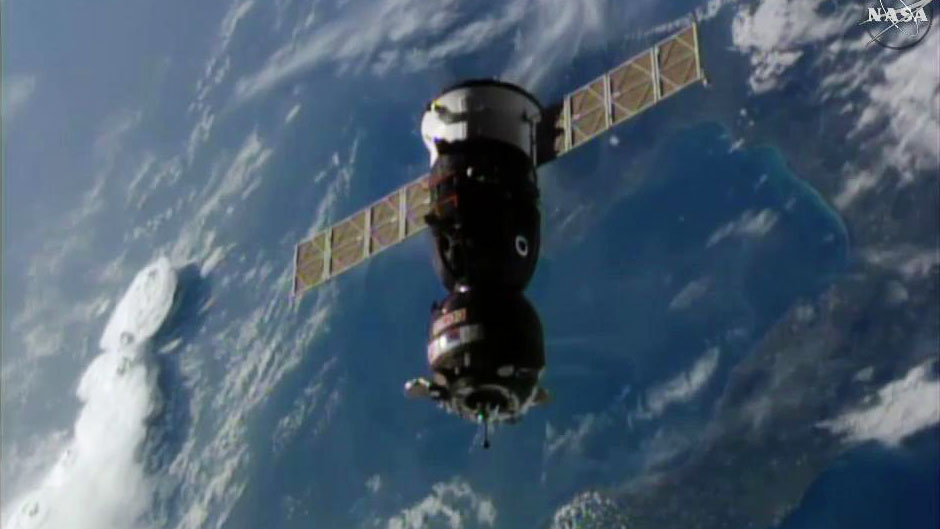
After almost seven weeks with a reduced crew of three, the International Space Station (ISS) was restored to its full six-person capability earlier today (Friday), with the smooth docking of Soyuz MS-02. Commanded by first-time cosmonaut Sergei Ryzhikov, and flanked by veteran spacefarers Andrei Borisenko and Shane Kimbrough, the Soyuz—which had completed a longer-than-normal two-day rendezvous profile, lasting 34 orbits—docked successfully at the station’s space-facing (or “zenith”) Poisk module at 5:52 a.m. EDT. Following customary pressurization and leak checks, the hatches into the ISS were opened at 8:20 a.m. EDT and the new arrivals were greeted by the incumbent Expedition 49 crew of Anatoli Ivanishin, Kate Rubins and Takuya Onishi.
From the dawn of its permanent habitation, way back in November 2000, the ISS was intended to support long-duration crews of three astronauts and cosmonauts, but downshifted to two-man “caretaker” crews for more than three years, in the wake of the Columbia tragedy. Three-person operations resumed in July 2006 and, from May 2009, with the addition of more crew quarters and expanded living and working capabilities, the station’s long-term crew was increased to six. Typically, these crews were launched via Soyuz, on a rotating basis, three people at a time, via “indirect handover”. In other words, a given subset of the crew would depart the station, temporarily reducing the population to three, before a new Soyuz delivered their replacements to restore it back up to six. A few exceptions to this rule have occurred and, for operational reasons, “direct handovers” have occasionally seen replacement crews arrive before the departure of their outgoing predecessors. Most recently, in September 2015, the Expedition 44 crew rose for a handful of days to nine personnel.
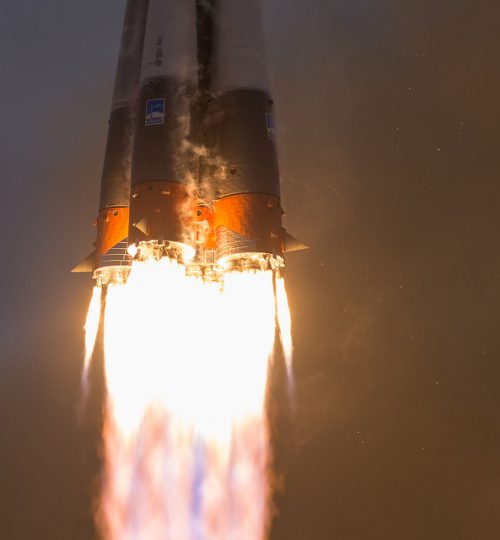
Direct handovers, though, have been the exception, rather than the rule, and an indirect handover was always planned on the current increment, following the departure of the Expedition 48 core crew on 6/7 September. Original plans called for Ivanishin, Rubins and Onishi to remain as a crew of three for three weeks, before Ryzhikov, Borisenko and Kimbrough arrived in late September. However, the Soyuz MS-02 launch was postponed by almost a month and Expedition 49 has spent far longer as a reduced-size crew than was intended. Speaking before Wednesday’s launch, Kimbrough expressed regret at the delays. It was “unfortunate”, he said, that the handover time between the two crews was so short and that his team would have to “soak up all the knowledge they can send our way”.
This handover time was shortened further by the fact that Soyuz MS-02 has followed a longer rendezvous profile. Rather than the customary six-hour and four-orbit regime, adopted by most Soyuz crews since March 2013, the first two flights by Russia’s new Soyuz-MS spacecraft have reverted to a two-day and 34-orbit rendezvous. This is necessary in order to validate modifications to the new vehicle, including testing its Kurs-NA (“Course”) rendezvous hardware and its ability to communicate via Russia’s Luch-5 (“Ray”) tracking and data-relay satellite network during up to 70 percent of each orbit, as well as to support ground command station functionality. Shorter rendezvous profiles are expected to resume with next month’s flight of Soyuz MS-03.
Immediately after entering orbit on Wednesday morning, Soyuz MS-02 unfurled its two electricity-generating solar arrays and its Kurs-NA apparatus, ahead of the first critical rendezvous burn to position it for a Friday docking at the ISS. A pair of “burns” of the spacecraft’s main propulsion system—situated at the rear of the Soyuz instrument module and fueled by nitrogen tetroxide and unsymmetrical dimethyl hydrazine—were executed during the third orbit, a couple of hours into the mission. Each burn lasted a little more than a minute to complete and served to raise Soyuz MS-02’s orbit to a perigee of 179 miles (289 km) and an apogee of 190 miles (307 km). Around eight hours after liftoff, Ryzhikov, Borisenko and Kimbrough settled down for their first night’s sleep on-orbit.
An additional maneuver was performed yesterday, preparatory to today’s final rendezvous sequence, which brought the spacecraft ever closer to the ISS. Today’s orbital ballet got underway at 3:34 a.m. EDT, at which time the Soyuz was still 62 miles (100 km) “below” its quarry. A single “burn” placed the incoming spacecraft inside the 125-mile (200 km) communications zone, after which the Kurs-NA hardware entered navigational communications with its counterpart on the ISS. A further burn, lasting 80 seconds, was performed at 4:44 a.m. “Per the standard rendezvous design,” Spaceflight101 noted, “Soyuz first targets a point 0.6 miles (1 km) from ISS in order to preserve the option of passively aborting its rendezvous and flying past ISS in case of any problems.”
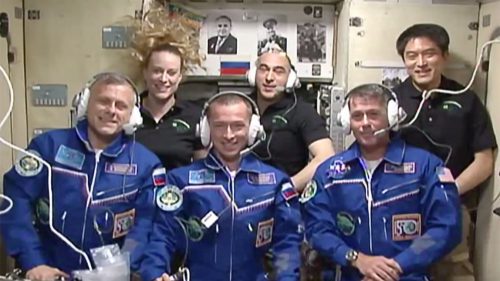
In this case, fortuitously, none were apparent. By 5:20 a.m. EDT, Soyuz MS-02 was barely 3 miles (5 km) away and a pair of braking burns served to guide the spacecraft towards its quarry. Shortly thereafter, Ryzhikov oversaw an autopilot-executed flyaround of the station to align himself with Poisk, which is located at the zenith port of the Zvezda service module on the Russian Orbital Segment (ROS). Docking occurred crisply at 5:52 a.m., about seven minutes ahead of schedule, and some 51 hours and 47 minutes after Soyuz MS-02 departed the Baikonur launch site in Kazakhstan. At the instant of docking, the spacecraft were flying about 251 miles (404 km) over Southern Russia.
“Hard-mate” between the two vehicles, whereby Soyuz MS-02’s docking probe retracted and hooks on opposing sides of the two spacecraft interfaces were closed, was confirmed at 5:59 a.m. The next couple of hours were spent undertaking pressurization and leak checks, before a jubilant Ivanishin, Rubins and Onishi opened the hatches and welcomed their three new crewmates aboard the space station.
With Expedition 49 due to end next week, and Ivanishin’s crew destined to return to Earth on 30 October, the sextet will have little time to conduct “handover” operations. Orbital ATK’s incoming OA-5 Cygnus cargo ship is also expected to arrive on Sunday morning, where it will be robotically captured by Rubins and Onishi, via the 57.7-foot-long (17.6-meter) Canadarm2 robotic arm, and berthed onto the Earth-facing (or “nadir”) port of the Unity node. With the departure of Ivanishin’s crew, Kimbrough will assume command of Expedition 50 and lead the station through late February 2017.
During that timeframe, Kimbrough’s increment will see the arrival of three new crew members—Russian cosmonaut Oleg Novitsky, Frenchman Thomas Pesquet and former NASA Chief Astronaut Peggy Whitson—on 16 November, together with a plate of cargo ships from national governments and commercial providers. Current plans anticipate a pair of Russian Progress cargo ships in December and February, Japan’s next H-II Transfer Vehicle (HTV) in December and another Orbital ATK Cygnus in February. SpaceX’s manifest remains in flux, following the on-the-pad loss of an Upgraded Falcon 9 on 1 September and it remains to be seen when the next ISS-bound Dragon will fly. Kimbrough’s crew is targeted to return to Earth on 25 February 2017, wrapping up an increment of 129 days in orbit.
Looking ahead, the ISS crewing manifest for 2017 is also uncertain. This uncertainty has been triggered by a pair of interrelated factors: firstly, Russia’s decision to reduce its annual number of Progress cargo flights from four to three, and secondly, ongoing delays to the launch of the Nauka (“Science”) Multi-Purpose Laboratory Module (MLM). The latter is expected to provide Russia’s scientific research hub aboard the station, but has been repeatedly delayed for almost a decade, due to technical and funding problems. According to current projections, the 42.6-foot-long (13-meter) MLM will fly no sooner than November 2017 and will be docked at the nadir port of the Zvezda module. Interestingly, this is directly opposite the docking location of today’s Soyuz MS-02.
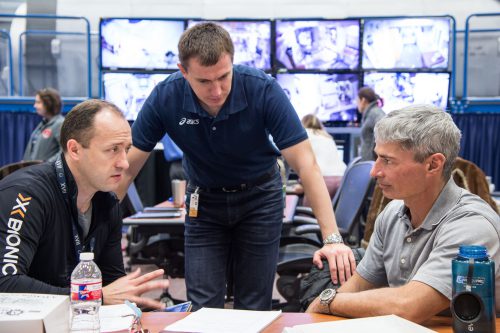
The delays already led to discussions earlier this year to reduce the present number of Russian cosmonauts aboard the ROS from three to two. And that may spell bad news for Nikolai Tikhonov and Ivan Vagner, both of whom were deep into training to launch aboard Soyuz MS-04 and Soyuz MS-06 in March and September 2017, respectively. According to NASA, the crewing situation for 2017 remains “Under Review”, but it has been suggested that the removal of Tikhonov and Vagner from their respective missions will produce the rare situation of a pair of two-man ISS increments—and possibly an expedition with just four crew members—in the fall of 2017 and spring of 2018.
Previous planning called for Soyuz MS-04 to launch in March 2017, carrying Tikhonov, his Russian crewmate Aleksandr Misurkin and NASA astronaut Mark Vande Hei, who would form the second half of Expedition 51 and later rotate into the core of Expedition 52, through September. Next up would have been Soyuz MS-05, launched in May 2017 with Russian cosmonaut Fyodor Yurchikhin, U.S. astronaut Jack Fischer and Italy’s Paolo Nespoli, who would join Expedition 52 and form Expedition 53 through November. The third piloted launch of the year would have been Soyuz MS-06 in September, crewed by Vagner and fellow Russian cosmonaut Aleksandr Skvortsov, together with NASA’s Scott Tingle. They would initially form part of Expedition 53 and rotate into Expedition 54 through early 2018. And finally, in November 2017, Soyuz MS-07 would deliver Russian cosmonaut Sergei Ryazansky, U.S. flyer Randy Bresnik and Japan Aerospace Exploration Agency (JAXA) astronaut Norishige Kanai to round out Expedition 54.
Although unconfirmed by NASA, the fluid situation now appears to have resulted in the possibility that the two-person remnant of the Misurkin and Skvortsov crews being shifted to the right and the Yurchikhin and Ryazansky three-person crews being advanced to the left. This would see Yurchikhin, Fischer and Nespoli—who are already primed as backups for Soyuz MS-03, which launches from Baikonur, four weeks hence—to become the new crew for Soyuz MS-04 in March 2017. Similarly, Ryazansky, Bresnik and Kanai would fly Soyuz MS-05 in May 2017, with Misurkin and Vande Hei launching on Soyuz MS-06 in September and Skvortsov and Tingle roaring into orbit aboard Soyuz MS-07 in November.
This potential arrangement would ensure continued six-person capability aboard the ISS through much of 2017, before reverting to just four men from September through at least March 2018. One possible reason for the slippage of the Misurkin and Skvortsov two-person crews is to allow additional training for Vande Hei and Tingle to upgrade to the Flight Engineer-1 position aboard the Soyuz. Originally, both NASA flyers trained as Flight Engineer-2, the right-seater, which does not require the same level of systems knowledge as Flight Engineer-1 in the left seat. “The retraining for FE-1 should be something like 3-4 months,” a source close to the Astronaut Office told AmericaSpace, but cautioned: “There may be other training involved, relating to ISS ops and visiting vehicles.”
As for poor Nikolai Tikhonov and Ivan Vagner, their future remains to be seen. The former was selected for cosmonaut training in October 2006, the latter in October 2010, and both would have been embarking on their first career space missions. There exists the possibility that Soyuz MS-06 and Soyuz MS-07 may carry additional cargo in place of the third crew seat. It seems unlikely that a Spaceflight Participant (SFP)—a fee-paying tourist—could be selected and trained in sufficient time, which raises the alternative possibility that Tikhonov or Vagner may be assigned to a short-duration “visiting” mission.
If the ISS crewing situation thus pans out, it is quite possible that the arrival of Misurkin and Vande Hei in September 2017 will see the station’s long-duration crew reduced to five members for the first time since March 2010. And when Ryzansky, Bresnik and Kanai return to Earth in November—to be replaced shortly thereafter by Skvortsov and Tingle—the ISS increment will shrink yet further, to just four men; the smallest long-duration crew size since 2009. How the crewing will run into 2018 remains to be seen, although the source told AmericaSpace that it was “frankly” doubtful that the MLM would launch in late 2017, raising the possibility of further two-person crews. And despite the increased ability to control payloads from the ground, there is another threat, too. “There will be hits to science,” the source told AmericaSpace, describing the situation as “inescapable”.
Want to keep up-to-date with all things space? Be sure to “Like” AmericaSpace on Facebook and follow us on Twitter: @AmericaSpace
Missions » ISS » Soyuz TMA-M » Missions » ISS » Soyuz TMA-M » Soyuz MS-02 »



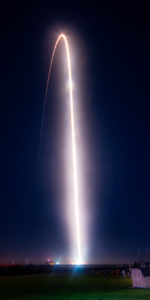
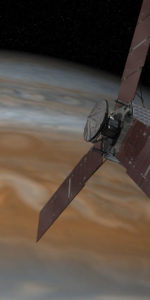
2 Comments
2 Pings & Trackbacks
Pingback:Multi-National Soyuz MS-01 Crew Prepares for Weekend Return to Earth « AmericaSpace
Pingback:As Soyuz MS-01 Lands, International Partners Look Ahead to Reduced Crewing in 2017 « AmericaSpace